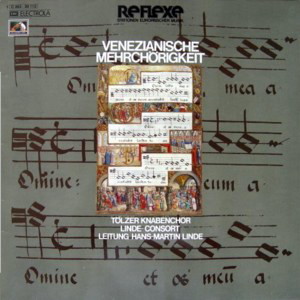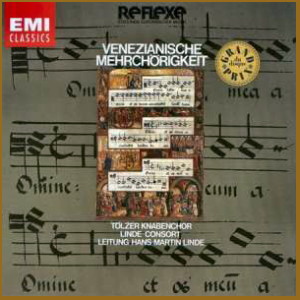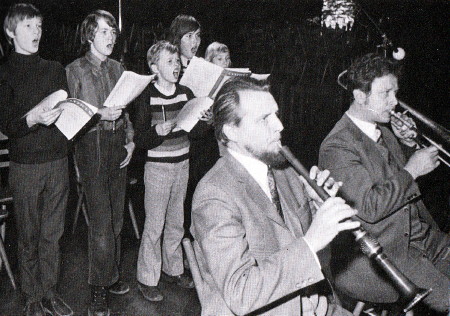 |
1 LP -
1C 063-30 112 - (p) 1973
|

|
| 1 CD - 8
26479 2 - (c) 2000 |
 |
| 1 CD -
CDM 7 63444 2 - (1991) |
|
Venezianische Mehrchörigkeit
|
|
|
|
|
|
Salomone
Rossi (1570?-1630?)
|
|
|
Tanzsätze
zu fünf Stimmen (erschienen
1607/08)
|
6' 27" |
|
| -
Vier Blockflöten, Fagott, zwei
Pommen, zwei Posaunen,
zwei Violinen, zwei Violen, Viola
da gamba, Violone, Gitarre,
Cembalo, Orgelpositiv |
|
|
|
|
|
| Orlando di
Lasso (Roland de Lassus)
(1532-1594) |
|
|
| I. Hor che la
nuova e vaga primavera
(erschienen 1575) - Madrigale zu
10 Stimmen in zwei Chören |
2' 51" |
|
| - Chor I: kleiner
Chor, vier Blockflöten, Fagott, Cembalo,
Laute |
|
|
| - Chor II:
großer Chor, zwei Violinen, zwei
Violen, Viola da gamba, Violone,
Orgelpositiv |
|
|
|
|
|
| Cesario Gussago (gest. 1611?) |
|
|
| Sonata "La
Leona" (erschienen 1608) zu
acht Stimmen in zwei Chören |
3' 25"
|
|
| - Chor I: Zink,
drei Blockflöten, Fagott, Orgelpositiv |
|
|
| - Chor II:
zwei Violinen, Viola, Viola da gamba,
Violone, Gitarre, Cembalo |
|
|
|
|
|
| Giovanni Gabrieli (1557-1612) |
|
|
| Canzone
(erschienen 1615) zu zwölf Stimmen
in drei Chören |
5' 07" |
|
| - Chor I: drei
Blockflöten, Fagott, Gitarre |
|
|
| - Chor II:
zwei Pommen, zwei Posaunen,
Orgelpositiv |
|
|
| - Chor III:
zwei Violinen, Viola, Viola da gamba,
Violone, Cembalo |
|
|
|
|
|
| Giovanni Croce (Joanne a
Cruce Clodiensis) (1557-1609) |
|
|
| II. Dialogo de
Chori d'Angeli (erschienen
1586) - Geistliche Madrigale zu
zehn Stimmen in zwei Chören |
3' 16" |
|
| - Chor I: kleiner
Chor, Gitarre, Cembalo, Fagott |
|
|
| - Chor II:
großer Chor, Orgelpositiv, Viola da
gamba, Violone |
|
|
|
|
|
| Claudio
Bramieri (gest. vor 1595) |
|
|
| Canzone "La
Foccara" (erschienen 1599)
zu acht Stimmen in zwei Chören |
4' 00" |
|
| - Chor I: drei
Blockflöten, Fagott, Orgelpositiv |
|
|
| - Chor II:
zwei Violinen, Viola, Viola da gamba,
Violone, Gitarre |
|
|
|
|
|
| Orlando di
Lasso (Roland de Lassus)
(1532-1594) |
|
|
| III. Trionfo del
Tempo (erschienen 1584) -
Madrigal zu zehn Stimmen in zwei
Chören |
2' 17" |
|
| - Chor I: Solosopran,
Blockflöte, Chor,Cembalo, Dulzian,
Laute |
|
|
| - Chor II:
Solosopran, Blockflöte, Chor, zwei
Violinen, Viola, Viola da gamba,
Violone, Orgelpositiv |
|
|
|
|
|
| Tiburtio Massaino (Massaini)
(16.-17. Jahrhdt.) |
|
|
| Canzone Nr.
XXXIV (erschienen 1608) zu
acht Stimmen in zwei Chören |
2' 46" |
|
| - Chor I: Zink,
Violine, Viola, Viola da gamba, Laute
|
|
|
| - Chor II:
Cembalo, Orgelpositiv, Violone |
|
|
|
|
|
| Andrea Gabrieli (1520-1586) |
|
|
| IV. O passi
sparsi (erschienen 1587) -
Madrigal zu zwölf Stimmen in zwei
Chören |
5' 00" |
|
| - Chor I: Singstimmen, zwei
Violinen, Viola da gamba, Cembalo |
|
|
| - Chor II:
Zink, Baßblockflöte, Altblockflöte,
Dulzian, zwei Posaunen, Violone,
Orgelpositiv |
|
|
|
|
|
| Giovanni Battista Grillo
(gest. 1622) |
|
|
| Canzone
(erschienen 1608) zu acht Stimmen
in zwei Chören |
4' 59" |
|
| - Chor I: Tenorblockflöten,
zwei Violinen, Viola da gamba, Gitarre,
Cembalo |
|
|
| - Chor II:
Dulzian, Viola, zwei Posaunen,
Orgelpositiv |
|
|
|
|
|
| Giovanni Gabrieli (1557-1612) |
|
|
| V. Omnes Gentes
("Sacrae Symphoniae", erschienen
1597) - Motette zu sechzehn
Stimmen in vier Chören |
4' 47" |
|
| - Chor I: Singstimmen
a capella |
|
|
| - Chor II:
Singstimmen a capella |
|
|
| - Chor III:
oberste Stimme gesunge, Pommer, zwei
Posaunen, Dulzian |
|
|
| - Chor IV:
drei Blockflöten, zwei Violinen, Viola
und Viola da gamba |
|
|
| - Continuo:
Laute, Cembalo, Orgelpositiv, Violone |
|
|
|
|
|
| TÖLZER KNABENCHOR
/ Gerhard Schmidt-Gaden, Einstudierung |
|
| LINDE-CONSORT
/ Hans-Martin Linde, Leitung |
|
| -
Peter Jenne, Annegret Schaub, Conrad
Steinmann, Verena Zacher, Blockflöte |
|
| -
Walter Stiftner, Dulzian,
Barockfagott |
|
| -
Edward H. Tarr, Zink |
|
| -
Alfred Sous, Helmut Schaarschmidt, Pommer |
|
| -
Heinrich Huber, Friedrich Werhahn,
Barockposaune |
|
| -
Herbert Höver, Miguel de la Fuente,
Barockvioline |
|
| -
Christoph Day, Dorothea Jappe, Barockviola |
|
| -
Michael Jappe, Viola da gamba |
|
| -
Angelo Viale, Violone |
|
| -
Konrad Ragossnig, Laute, Gitarre |
|
| -
Rudolf Scheidegger, Cembalo |
|
| -
Eduard Müller, Orgelpositiv |
|
|
|
|
|
Luogo
e data di registrazione |
|
Bürgerbräu,
München (Germania) - gennaio 1973 |
|
|
Registrazione: live /
studio |
|
studio |
|
|
Producer / Engineer |
|
Gerd
Berg / Johann Nikolaus Matthes
|
|
|
Prima Edizione LP |
|
EMI
Electrola "Reflexe" - 1C 063-30
112 - (1 lp) - durata 45' 21" -
(p) 1973 - Analogico |
|
|
Prima Edizione CD |
|
EMI
"Classics" - CDM 7 634449 2 - (1
cd) - durata 45' 21" - (c) 1991 -
ADD |
|
|
Edition CD |
|
EMI
"Classics" - 8 26479 2 - (1 cd) -
durata 45' 21" - (c) 2000 - ADD |
|
|
Note |
|
- |
|
|
|
|
|
 A visitor to
Venice in 1608, hearing
polychoral music for the
first time, felt he was
“transported to the third
heaven, like St. Paul.” At
about the same date, the
secretary of the Queen of
France reported that “the
church was filled with
magnificent harmony at a
concert of vocal and
instrumental music given by
the finest local musicians,
mainly on six portable
organs, also on the
excellent main organ, on
trumpets and bassoons,
oboes, viols, violoni, lutes,
cornets, recorders and
flutes.” Many North Italian
composers had abandoned the
severe contrapuntal style in
favour of a more homophonic
and sonorous music. Gioseffo
Zarlino, the distinguished
director of music at San Marco
from 1565 to 1590, felt
constrained to refer the
traditionalists (who were
mainly to be found among the
theoreticians) to the
convincing results produced
in practice. He points out
the characteristics and
virtues of the new style,
and speaks of the grouping
of two or more choirs: “Each
choir is divided into four
or more parts. First one
choir will sing and then
another, or they will
alternate; and occasionally
they all sing together, and
this is highly effective." A visitor to
Venice in 1608, hearing
polychoral music for the
first time, felt he was
“transported to the third
heaven, like St. Paul.” At
about the same date, the
secretary of the Queen of
France reported that “the
church was filled with
magnificent harmony at a
concert of vocal and
instrumental music given by
the finest local musicians,
mainly on six portable
organs, also on the
excellent main organ, on
trumpets and bassoons,
oboes, viols, violoni, lutes,
cornets, recorders and
flutes.” Many North Italian
composers had abandoned the
severe contrapuntal style in
favour of a more homophonic
and sonorous music. Gioseffo
Zarlino, the distinguished
director of music at San Marco
from 1565 to 1590, felt
constrained to refer the
traditionalists (who were
mainly to be found among the
theoreticians) to the
convincing results produced
in practice. He points out
the characteristics and
virtues of the new style,
and speaks of the grouping
of two or more choirs: “Each
choir is divided into four
or more parts. First one
choir will sing and then
another, or they will
alternate; and occasionally
they all sing together, and
this is highly effective."
The most striking feature of
polychoral music is its
sound, which as it were
divides up the space and
spans it at the same time.
The changed dimensions of
the Copernican universe, and
the contrasting of infinity
and human limitations by
theologians and
philosophers, had introduced
new concepts of space. The
opening-out of the visible
and invisible world also
found expression in the
arts. Painters used
perspective and its effect
on the eye of the viewer.
Architects brought the
various parts of a large
space into relationship
with each other, and
proportion
and function played an
essential role. And the
composers produced an
entirely new aural
experience by
positioning groups of
players and singers at
different points.
Heinrich Besseler (in
"Musik und Raum," 1928)
describes the resultant
sonority as "a
reaching-out of word and
sound across a vast and
superhuman space."
It
was the task of the
director of music to
produce a balance of
sound between singers
and players and an
audible contrast
between the various
groups, and quite
often itwas also up to
him to divide up the
score between
different choirs. The
composer always
indicated that his
work was to be split
up amongst a certain
number of choirs. But
it was left entirely
to the performers to
decide how big each
was to be and how the
vocal and instrumental
parts were to be
assigned. The
contrasting of large
and small choirs or
choirs of the same
size, of soli and
tutti, of voice and
instruments either
together or
separately, of light
and shade, loud and
soft, near and far -
all this produced a
brilliant variety of
sound. There was such
a degree of freedom
that, for example, “in
the event of a lack of
sopranos and a
superfluity of
tenors,” the latter
could take over the
part of the former
(Giovanni Ghizzolo,
1619). The exchanging
of parts was
permitted, and each
choir could be
subdivided - providing
there were enough
partbooks to go round.
Soloists - whether
vocal or instrumental
- could take over one
part and the continuo
instruments would play
the others. In
this recording much
use is made of these
and many other
possibilities.
From 1565 on,
instrumentalists were
a permanent part of
the choir of San Marco.
The development of
independent
instrumental pieces
did not at first mean
that they were
composed in a style
appropriate to the
particular
instruments. Such
works could be played
at will “cum omnis
generis instrumentis.”
In this recording
there are pieces
played by families of
instruments and others
by mixed groups; solo
instruments are set
off one against the
other; strings and
wind are divided;
keyboard instruments
used as an independent
choir. The
fountainhead of
polychoral music was
Venice. Around the
year 1600, numerous
North Italian and
foreign musicians were
studying there.
Heinrich Schütz,
Hans Leo Hassler,
Gregor Aichinger,
Giovanni Battista
Grillo and many others
came “to visit and
listen to that paragon
of all perfect music
and jewel of Italy,
Giovanni Gabrieli”
(Christoph Klemsee,
1613). Before that
date, the personal
friendship between
Andrea Gabrieli and
Orlando Lasso (22
years his junior) had
been the cause of the
Venetian polychoral
style becoming known
north of the Alps; and
after the two
composers had made a
journey together and
Lasso had paid several
visits to Venice, the
composer to the Munich
court adopted the
“Venetian manner"
wholeheartedly.
Hans-Martin
Linde
Translation
by David Potter
|
|
|
EMI Electrola
"Reflexe"
|
|
|
|

